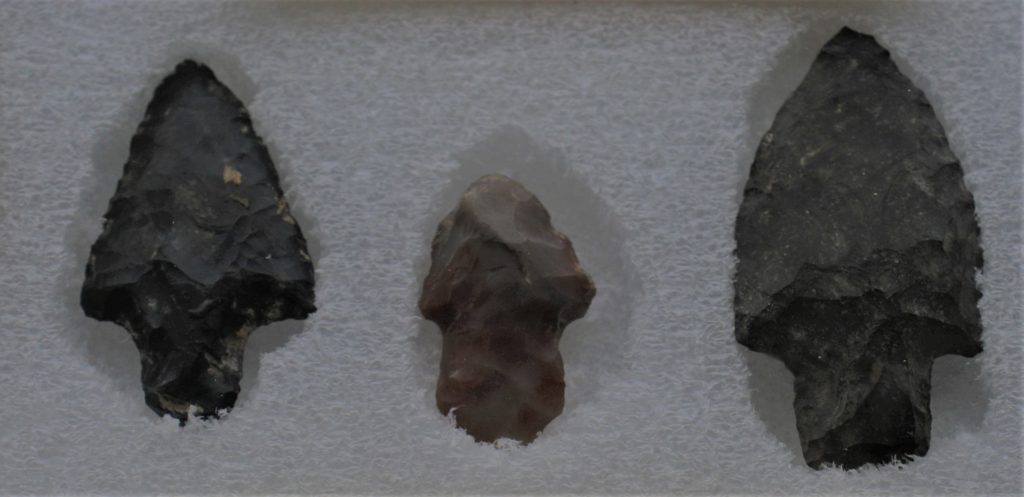Azubah Phelps came to Blendon with her husband and six children in 1806. Decades later, she wrote, “It was a great undertaking to leave our native state [Connecticut], our relatives and friends, and go such a long distance to this then wilderness of Ohio…”[1]
But contrary to the image conjured by Phelps’ claim, they didn’t hack their way through a virgin wilderness. Instead, the Phelps were participating in part of a larger government-sanctioned effort to bolster the United States’ power and wealth, a process that was rooted in the violent invasion of Indigenous lands, white supremacy, and genocide. A key component of settler-colonialism, as this process is called, was the erasure of Native peoples.[2]
Definitions
Additional Resource
Museum in a Box: American Indian Life & History
From Phelps’ letter, you would never know that Ohio already had over 10,000 years of human history. But that history was etched into the landscape. The Phelps built their cabin along a Native American road that they would’ve taken to go into the nearest town, Worthington, for supplies. They would have wondered at the large earthen, man-made mounds along Big Walnut creek and on their neighbors’ land to the north (in present-day Westerville). These mounds were over 1,000 years old and testified to the former presence of the Adena and other Native cultures. White settlers continued to find a plethora of pre-contact Indigenous points on their farms for well over a century. It would have been obvious that other people called this land “home” first.[3]
By the 1700s, Ohio was populated by Native nations like the Wyandot, who had been displaced from their original homes by white settler encroachment and warfare with other Native nations. The Phelps’ move to Ohio in 1806 was made possible by white armed forces that destroyed these refugee villages over a decade earlier. The 1795 Treaty of Greenville forced the Indigenous survivors into the northwest corner of the state. They could only cross the treaty line to hunt. The US government soon surveyed the forcibly cleared lands and gave land warrants to Revolutionary War veterans, who often sold them to land speculators – this is what happened in Blendon Township. Although the township was south of the treaty line, male settlers joined militias during the War of 1812, which collectively enabled the continued theft of Native land through constant invasions and forced treaties. They were so frightened of “cross and unfriendly” Natives that they built a wooden fort for protection near where Pioneer Cemetery now is. Their writings frame their actions as self-defense but don’t offer any reflection on their own role in perpetuating the cycle of violence between Native nations and the US.[4]
Definitions
People who would buy large quantities of land at cheap prices & sell it at a higher price.
References
[1] Azubah Phelps, letter to Eldad Barber Moore (G19053), File on Griswold-Phelps Family (G19), 3/17/1839, Westerville History Museum.
[2] See Roxanne Dunbar-Ortiz, An Indigenous Peoples’ History of the United States (Boston: Beacon Press, 2014) and Roxanne Dunbar-Ortiz, Not a Nation of Immigrants: Settler Colonialism, White Supremacy, and a History of Erasure and Exclusion (Boston: Beacon Press, 2021).
[3] A Centennial Biographical History of the City of Columbus and Franklin County, Ohio (Columbus: Lewis Publishing Company, 1901), 507; H. Warren Phelps, “Settlement of Blendon Township,” Old Northwest Quarterly Vol. 10 (Jan. 1907), 127; Robert W. McCormick, “A Cultural History of Sharon Woods Metro Park” (P06137), File on Parks, Metropolitan (P06), Westerville History Museum; Indigenous Peoples Vertical File (I01), Westerville History Museum.
[4] A Centennial Biographical History of the City of Columbus; Phelps, “Settlement of Blendon Township”; memories of Minerva Griswold Westervelt in “Centennial of the Griswold Family” in Harold Hancock, Our Ancestors of the Westerville Area: A Genealogical History (Westerville Historical Society, 1981), 281-285.
How to Cite This Source
Please cite this toolkit (Chicago Manual of Style) as 'Westerville History Museum, "Racism in Westerville History," Westerville Public Library, last modified January 23, 2023, https://westervillelibrary.org/racism-history.
Need a citation in a different style (such as MLA or APA)? Try this citation generator.







